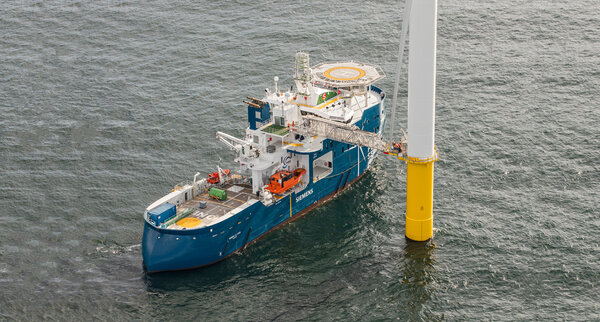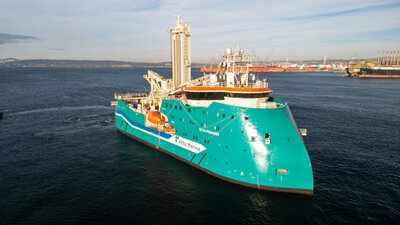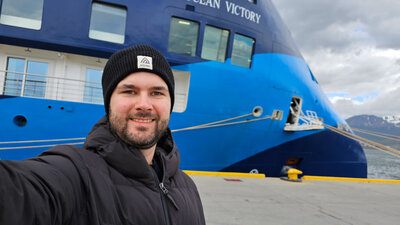The crews on current operating Service Operation Vessels (SOVs) report that they prefer to manoeuver stern first during their stay at the offshore wind farms.
The SOV crews give various reasons for astern operations:
- All the work is being performed at the aft. Keeping the aft first leads to a better overview of the vessel's positioning, as the gangway, the turbine and the ship's side can all be observed from the bridge
- Most power is installed in the aft part of the ship, enabling it to keep positioned more easily
- The vessel doesn't have to turn around before leaving for the next turbine, saving manoeuvering time between turbines
Crews on X-STERN vessels have additional reasons for operating astern:
- The X-STERN is kept towards the weather while on standby during night. The service crews get complete rest in between their maintenance shift due to no slamming or vibrations
- There will also be no slamming due to the X-STERN while on DP or even when transferring between the turbines
- If the weather is not too adverse, the ship stays on the spot with two thrusters running, which leads to substantial reduction in fuel consumption
Read the story of the senior DP operator on the first X-STERN vessel: HARD ROCKER AT WORK
First X-STERN vessels
The X-STERN was firstly implemented on the Windea La Cour. This 88m-long SOV is an SX175 design from ULSTEIN. The X-STERN aft design has been developed for the SOVs to work close to the offshore wind farm structures, disregarding the directions of wind or waves, or where it is headed next. The X-STERN is a follow-up of the X-BOW fore ship design, both originating from Ulstein's long experience in designing for the offshore industry.
Backing ability tested on first sea trial
A vessel's ability to back is not a feature usually being tested at sea trials. However, the owner's crew decided to try out the new stern solution on the sea trial of the first X-STERN vessel.
The film below shows the results when the BS Offshore crew decided to test the Windea La Cour's ability to sail astern at max speed.
Vertical transom plate versus the X-STERN
The X-STERN was designed for increased operability and station-keeping whilst in dynamic positioning mode. The vertical transom plate, a very common aft shape, will create slamming when going backwards or when being positioned with the stern towards waves, wind and current. The X-STERN, however, is a pointed aft. The sloping and higher stern, with its sharp stern shape, improves offshore wind farm service and maintenance. This has an importance when it comes to the flexibility and efficiency of the vessel. The X-STERN improves the crew and passenger comfort and increases the operability through positive effects on station keeping, wave response and safety in harsh conditions. It operates with reduced power and fuel consumption while staying positioned.
Keeping up backward speed without reducing comfort
A vessel with the X-STERN can keep almost the same speed in backward mode as in forward mode without the occurrence of slamming or vibrations. 'Windea La Cour' has demonstrated the ability to sail astern at a speed of 12.1 knots, just 1.8 knots shy of her forward speed, and she is easily manoeuvred both ways. The crew management has noted the vessel's smooth motions and the very low levels of noise and vibrations, all these being important factors in a vessel in which one of the main tasks is to transport and accommodate service technicians. The 'Windea La Cour' and her sister vessel, the 'Windea Leibniz', were delivered from Ulstein Verft to ship owner BS Offshore (Bernhard Schulte) in 2016 and 2017.
Several SOV deliveries
Ulstein has developed several SOVs. First off was the Siem Moxie (2014), now Seaway Moxie, currently operating for Subsea7. She often takes on assignments as an Installation Support Vessel in a duo with a cable laying vessel. Then comes the first X-STERN vessels: Windea La Cour (2016), Windea Leibniz (2017), Acta Auriga (2018), Acta Centaurus (2019). Bernhard Schulte, the owner of the Windea vessels, additionally has one more SOV on order from Ulstein Verft for delivery in 2020.



